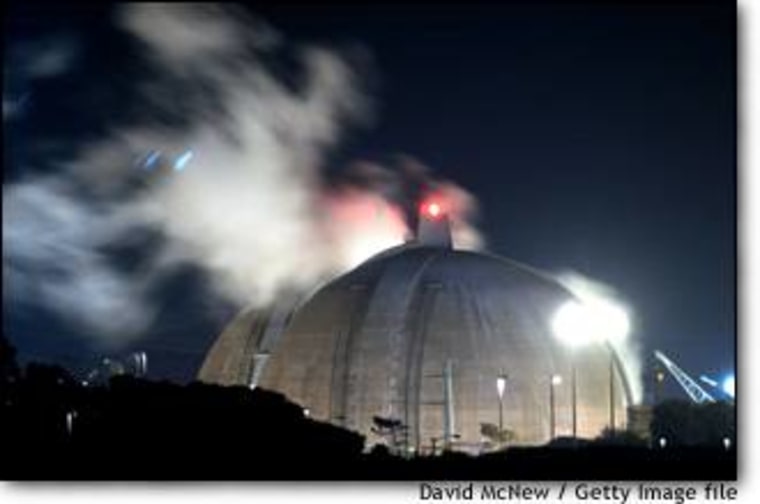Nuclear power plants provide one fifth of the electricity in the U.S. And running a plant has always carried risks. It can be dangerous work on the inside — and on the outside, especially in the new era of terrorist threats.
The nuclear power industry has has often been embroiled in controversy, and that has always made these plants targets. Long before 9-11, security officers went through paramilitary training, carried semi-automatic weapons, and employees were subjected to background checks and daily screenings. As for construction, reactors were built to withstand attacks from Mother Nature like earthquakes. Reactor walls have even been tested to withstand the impact of an F-4 jet: one 1980s test destroyed the jet, not the wall.
But it wasn’t an F-4 that smashed into the Pentagon or the World Trade Center — it was a jumbo jet. And the terrorists threats these days don’t necessarily involve environmentalists — but suicide bombers. Now comes word that two months after 9-11, only one out of five security officers at New York’s Indian Point nuclear power plant felt they could protect the facility from such a terror attack, and say they were discouraged from speaking out. So this security — and image — sensitive industry has had to step up to do more.
“Since 9/11, the industry has expanded about an additional $370 million on security measures,” according to Steve Floyd, senior director of regulatory reform at the Nuclear Energy Institute.
Most of that money has gone to hiring and training 2,000 more officers for more than 60 plants.
At Southern California Edison’s San Onofre nuclear power plant, for example, security spending has jumped 35 percent since 9/11 to well over $10 million a year. Some of that has gone to hiring about 60 new officers.
Other new measures include extending the security perimeter around plants. And in response to concerns about even bigger truck bombs, vehicles are now searched as far as a mile away from the main buildings.
Oceanfront facilities now have no boating zones patrolled by the Coast Guard.
“We’ve also reduced the number of entrances and exits out of the plant,” said Ray Golden, a spokesman for Southern California Edison.
Jumbo jet impact
And what about withstanding the impact of a jumbo jet? Computer simulations are trying to determine just that.
“There’s nothing in the research so far nothing to suggest these commercial airliners would be able to penetrate the containment building,” said Floyd.
“The walls on that building are four feet to seven foot thick, steel-reinforced rebar that’s thicker than my wrist,” said Golden.
The walls are not quite as thick around the radioactive waste buildings. But those buildings have much smaller profiles than a reactor; they’d be difficult for an airplane to hit.
Yet even if the plant could survive one airplane, what about a sustained attack?
“If somebody came over to our shores with battleships and started firing Tomahawk missiles or nuclear weapons or anything else,” said Golden, “at some point it become now the end of the private security force and into the federal government’s need to deal with it.”
And in San Onofre’s case, it’s lucky. It’s landlord and next-door neighbor is Camp Pendleton, one of the largest marine bases in the world.
But what about an attack from the inside a nuclear plant?
Dr. Najmedin Meshkati, a professor of engineering at the University of Southern California, has been studying and consulting on plant safety for 20 years.
“There are some Achilles heels within the plants that they could be aggravated by outside the plant,” he said.. “The combination of these two seemingly independent events could make the plants very vulnerable.”
Meshkati says he won’t be specific about the Achilles heels for security reasons.
But past training exercises by government agents at plants across the country have proven security can be compromised. Cyber terrorism is an issue that continues to be studied; technicians at San Onofre train for possible hacker attacks in a mock-up of the plant’s control room.
”(Cyberterrorists) would take the plant off the line by interrupting the power to the switch yard at the plants,” said Floyd.
In other words, they could potentially cause a shutdown, but not a leak.
The industry believes it can continue to be profitable and make its facilities safer, to make them both hard and hardened: hard to sabotage and hardened against attack. So that when terrorists consider potential targets, they’ll look somewhere else.
